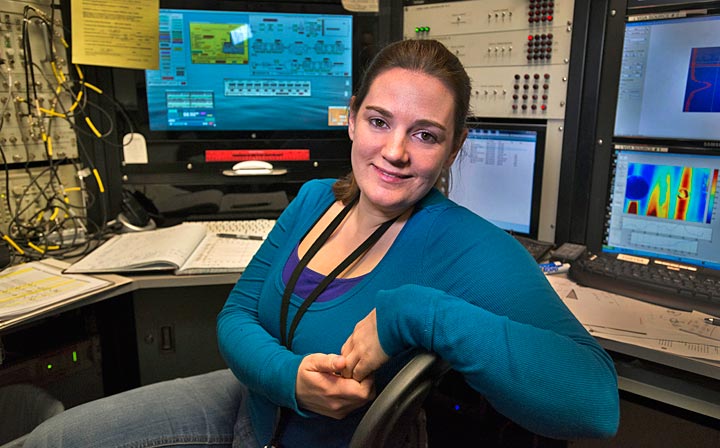Women @ Energy: Christina Swinson
April 23, 2013
In March 2013, the U.S. Department of Energy (DOE) launched a new series, "Women @ Energy," to highlight women who are improving the world through their careers in Science, Technology, Engineering and Mathematics (STEM) across the DOE complex. To date, seven Brookhaven scientists have been featured.

Christina Swinson is a post doc. in Accelerator Physics at Brookhaven National Lab. She has a BSc. In Physics with Computing, Queen Mary College, University of London, United Kingdom, and a DPhil. (PhD.) in Accelerator Physics from the University of Oxford, United Kingtom.
What inspired you to work in STEM?
My decision to work in STEM didn't come until I was in my twenties but the journey first began in high school. Unfortunately at the time I wasn't encouraged past the point of getting good grades, that I would become a physicist didn't cross the minds of my teachers, let alone my own mind. Fortunately I stuck with STEM, though probably only because I found more success in these subjects. I naturally went on to study my strongest subjects at University. After the first year I chose to study Physics because I got the most enjoyment out of it, I was also encouraged by the unusually high percentage of females in my classes (almost 50%). Toward the end of my undergraduate degree I was decided to try some accelerator physics research for my dissertation. My supervisor encouraged me to apply for a graduate program in accelerator physics and to go on to make a career of it. I am pleased to note that my high school now specializes in science education, working toward equal male/female representation in STEM.
What excites you about your work at the Energy Department?
I chose to work at Brookhaven Lab because of my previous experience (during my student research projects) of Department of Energy affiliated labs as centers of scientific excellence. When I arrived I found that Brookhaven National Lab fits perfectly into this category. Here, I am excited to participate in cutting edge accelerator research at the Accelerator Test Facility, a facility with unique capabilities and the home to many firsts in accelerator physics.
How can our country engage more women, girls, and other underrepresented groups in STEM?
Encouraging underrepresented groups into STEM seems fraught with problems. As a minority in STEM it is sometimes difficult to judge whether some opportunities made available to me are offered due to my academic capability or my gender. I feel that whilst dedicating resources to encouraging girls and women into STEM is essential, one must be careful not to give the impression that women are not capable of succeeding in STEM without special help. There seems to be significant evidence that underrepresentation of women in STEM is partly caused by societal behavior and so it is important to ensure that girls participate fully in STEM subjects at elementary school level..
Do you have tips you'd recommend for someone looking to enter your field of work?
As with all areas of work, experience and the support of someone already in your chosen field are key. It is important to gain as much research experience as possible during college education. A sure fire way to find opportunities for research and to meet the right people is by volunteering and participating in societies. Tutor younger students, join the American Institute of Physics and other important societies and even volunteer to judge the science fair at your local school. It is also important to make the most of your college professors, they are there for your benefit.
When you have free time, what are your hobbies?
When not working on accelerators I like to spend time outdoors. I particularly enjoy mountaineering, hiking and rock climbing. When I am not outdoors I, as is the case with many scientists, enjoy science. I am interested in many areas outside my field including water rockets, soda volcanoes and non Newtonian fluids.
2013-3879 | INT/EXT | Newsroom









